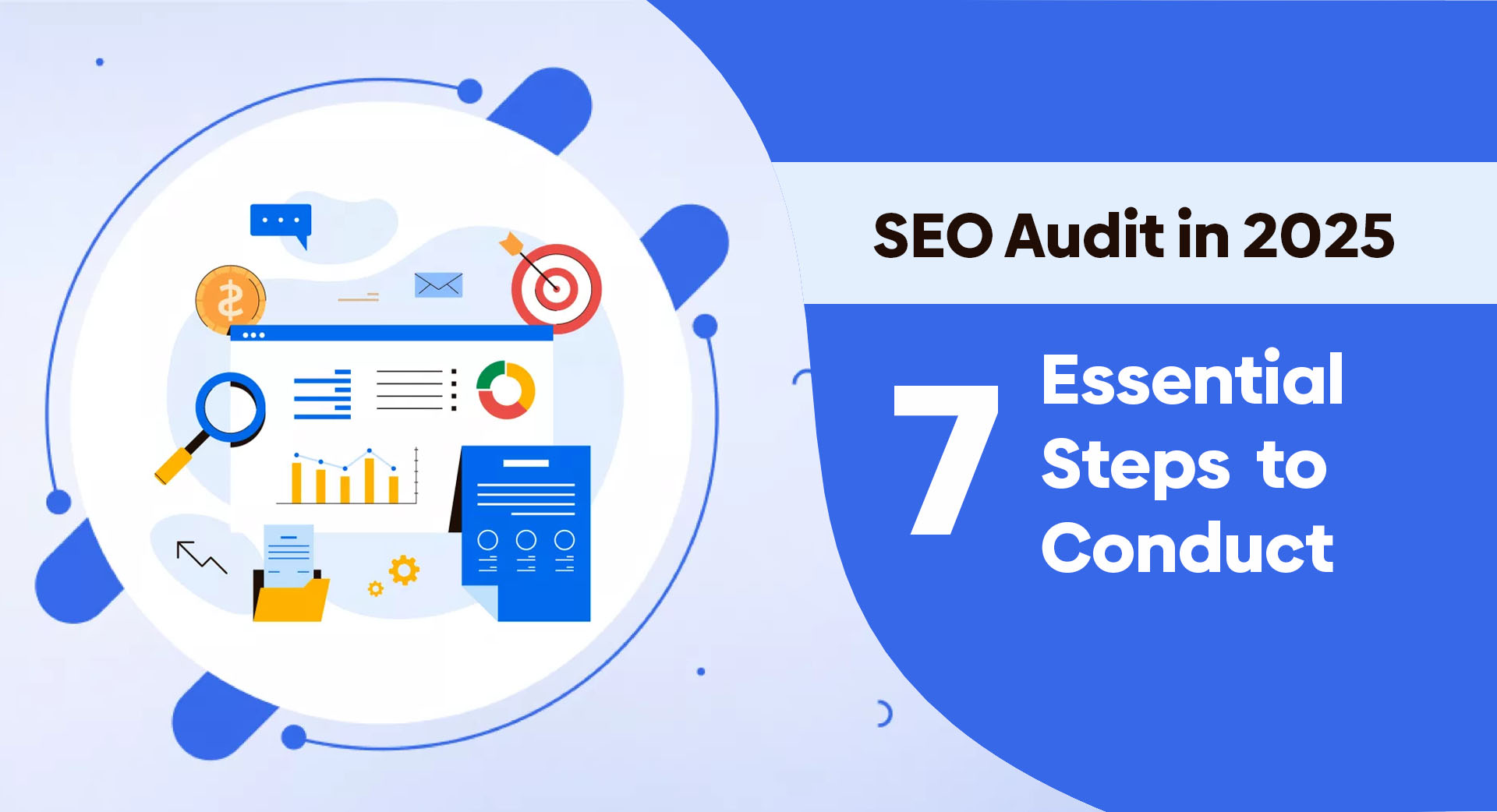Are you struggling to get your website to rank higher? Whether it be an on-page vs. off-page SEO or a well-structured SEO audit checklist, these aspects can make all the difference! Just like regular health check-ups keep you fit, your website needs an SEO site analysis to identify issues, fix them, and enhance overall performance.
From considering a technical SEO audit, following an on-page SEO checklist, or evaluating off-page SEO factors, performing an SEO audit is the key.
In this blog, I am here to simplify the SEO audit checklist for you, covering everything from a website performance audit and keyword optimization audit to the SEO audit best practices for 2025. So, without ado, let us quickly dive in!
What is an SEO Audit & Why Is It Important?

Before jumping into a complete SEO site audit for higher Google rankings, let us first break down the basics. To put it simply, an SEO audit is a comprehensive check-up of your website’s health. Some of the key importance of running website health check SEO include:
- It helps to identify technical issues affecting website performance.
- It helps improve search engine rankings.
- It enhances user experience and site speed.
- It helps optimize on-page and off-page SEO factors.
- It detects keyword gaps and optimization opportunities.
- It ensures mobile-friendliness and responsiveness.
- It strengthens website security and indexing.
Now, let us dive into the 7-step SEO audit process.
7 Essential Steps to Conduct an SEO Audit in 2025

- Check Core Web Vitals & UX
The first step on the step-by-step SEO audit checklist for beginners is to evaluate Core Web Vitals and user experience. Google cares about how fast your site loads, how quickly users can interact with it, and how stable the layout is. Slow pages, confusing navigation, or shifting content can make visitors leave and hurt your rankings.
How to Do?
Focus on improving loading speed, make sure your site works well on mobile, and keep the design smooth and easy to use. - Fix Technical SEO Issues
The second step on the list of 7 steps to Google SEO checklist is to ensure your website’s technical setup allows search engines to crawl and index it properly. Technical SEO audit covers behind-the-scenes elements that impact how well your site appears in search results. Issues like broken links, slow loading speeds, duplicate content, and incorrect redirects can harm your rankings.
How to Do?
Use Google Search Console to find and fix errors, update your sitemap, ensure proper redirects, and add Schema markup to improve visibility. - Optimize On-Page SEO
The third step in SEO site analysis is to follow an on-page SEO checklist. This Google SEO checklist focuses on elements like titles, meta descriptions, headers, and content quality. This will help improve readability, boost engagement, and help search engines understand your content better.
How to Do?
Use clear titles and descriptions, place keywords naturally, structure content with headers, add image alt text, and link related pages within your site. - Audit Content for EEAT
The fourth step on the list of on-page and off-page SEO audit guides is to review your content based on Google’s EEAT or Experience, Expertise, Authority, and Trustworthiness guidelines. Consider producing high-quality content that is valuable to users. Outdated, duplicate, or low-quality content can hurt rankings, reducing credibility and search visibility.
How to Do?
Ensure content is keyword-optimized without overstuffing, includes expert insights, cites authoritative sources, and is regularly updated to stay relevant. - Ensure Mobile & Voice Search Readiness
The fifth step on the list of SEO audit checklists is to optimize your website for mobile-first indexing and voice search. Google prioritizes mobile-friendly websites, so having a responsive design, fast-loading pages, and easy-to-read content on smaller screens is essential.
How to Do?
Ensure your site is mobile-friendly, loads quickly, has readable text and is structured for voice search using natural language and question-based content. - Audit Backlinks & Off-Page SEO
The sixth step on the list of the SEO audit checklist is to focus on off-page SEO factors. Check your backlinks and overall strategy to ensure you are getting links from high-authority sites. Avoid spammy links, as they can hurt your rankings.
How to Do?
Conduct a backlink audit to remove toxic links, earn quality backlinks from trusted sources, diversify anchor text, and leverage social media marketing and digital PR. - Track & Improve SEO Performance
The seventh and final step in the SEO audit checklist is to continuously monitor and improve your website’s performance. SEO is an ongoing process, and regular tracking helps identify new opportunities, fix emerging issues, and adapt to algorithm updates.
How to Do?
Consider using tools like Google Analytics, Google Search Console, and SEMrush for tracking keyword rankings and organic traffic, monitoring user behavior and engagement metrics, and adjusting SEO strategies based on real-time data.
That’s a wrap on the step-by-step guide for the SEO audit checklist. Now, whether you need to perform a website performance audit or a keyword optimization audit, understanding the best SEO audit practices for 2025 will help you optimize your site according to key SEO ranking factors.
Top 3 Best Practices for Website Health Check SEO
Here are three best practices for conducting a website health check SEO.
1. Use AI & Automation
The first SEO audit best practice for 2025 is to leverage AI-powered SEO tools for efficiency and accuracy. AI can help identify keyword gaps, automate technical audits, and monitor SEO performance in real-time, making the audit process smoother and more effective.
2. Optimize for Voice Search
The second SEO audit best practice for 2025 is to make your content voice-search-friendly. With the rise of voice assistants, focusing on conversational keywords and question-based queries can improve keyword optimization audits and help your site appear in voice search results.
3. Improve Internal Linking Structure
The third SEO audit best practice for 2025 is to build a strong internal linking strategy. Proper linking helps search engines understand your site structure and enhances SEO ranking factors by distributing page authority across important content pages.
Final Words
Performing a comprehensive SEO audit is crucial for maintaining website health, improving rankings, and staying ahead in the competitive digital landscape. By following this step-by-step SEO audit checklist, you can ensure your site is optimized for search engines, user experience, and the latest SEO trends.
Struggling with SEO or have questions about optimizing your website? Let us talk! Drop your thoughts in the comments or subscribe to my blog for the latest SEO insights and updates!
FAQs
1. How to conduct an SEO audit for a website?
Ans. To conduct an SEO audit for a website, start by analyzing Core Web Vitals, technical SEO, on-page elements, content quality, mobile-friendliness, backlinks, and performance tracking. Use tools like Google Search Console, SEMrush, or Ahrefs to identify issues and optimize for better rankings.
2. What are the best SEO audit tools for website analysis?
Ans. Some of the best SEO audit tools include Google Search Console, SEMrush, Ahrefs, Moz, Screaming Frog, and Surfer SEO. These tools help in tracking technical errors, keyword rankings, backlinks, and website performance.
3. What is the technical SEO audit checklist for better rankings?
Ans. A technical SEO audit checklist includes checking site speed, fixing broken links, optimizing crawlability, ensuring mobile responsiveness, updating sitemaps, adding Schema markup, and resolving duplicate content issues. These factors help search engines index and rank your site better.
4. How to improve website SEO with an audit?
Ans. To improve website SEO with an audit, identify weak areas like slow loading speed, poor content, missing keywords, and technical issues. Additionally, consider optimizing page speed, enhancing content quality, fixing errors, improving mobile usability, and building high-quality backlinks for better rankings.
5. How to analyze website SEO performance effectively?
Ans. To analyze website SEO performance, track key metrics like organic traffic, keyword rankings, bounce rate, page speed, and backlinks using Google Analytics, Google Search Console, and SEO tools. Analyzing these on regular analysis will help in spotting issues and improving performance.
6. What are some of the common SEO audit mistakes and how to fix them?
Ans. Some common SEO audit mistakes include ignoring mobile optimization, neglecting site speed, keyword stuffing, overlooking technical errors, and not updating content. Fix them by ensuring a mobile-friendly site, improving loading speed, using keywords naturally, resolving technical issues, and refreshing outdated content.

